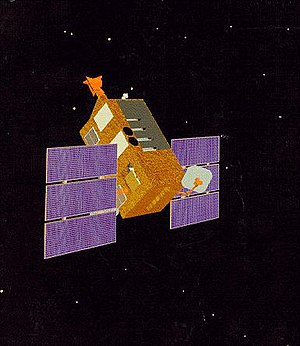Rossi X-ray Timing Explorer

Artist impression of RXTE telescope
|
|||||||
| Names | RXTE XTE Explorer 69 |
||||||
|---|---|---|---|---|---|---|---|
| Mission type | Astronomy | ||||||
| Operator | NASA | ||||||
| COSPAR ID | 1995-074A | ||||||
| SATCAT no. | 23757 | ||||||
| Website | RXTE home page | ||||||
| Mission duration | 16 years, 6 days | ||||||
| Spacecraft properties | |||||||
| Manufacturer |
GSFC MIT (All-Sky Monitor) |
||||||
| Launch mass | 3,200 kg (7,100 lb) | ||||||
| Power | 800 W | ||||||
| Start of mission | |||||||
| Launch date | 13:48, December 30, 1995 | ||||||
| Rocket | Delta II 7920 | ||||||
| Launch site | Cape Canaveral SLC-17A | ||||||
| End of mission | |||||||
| Disposal | decommissioned | ||||||
| Deactivated | January 5, 2012 | ||||||
| Orbital parameters | |||||||
| Reference system | Geocentric | ||||||
| Regime | Low Earth | ||||||
| Semi-major axis | 6,753 km (4,196 mi) | ||||||
| Eccentricity | 0.0002672 | ||||||
| Perigee | 380.9 km (236.7 mi) | ||||||
| Apogee | 384.5 km (238.9 mi) | ||||||
| Inclination | 22.9842 degrees | ||||||
| Period | 92.1 minutes | ||||||
| RAAN | 221.8627 degrees | ||||||
| Argument of perigee | 256.7652 degrees | ||||||
| Mean anomaly | 103.2545 degrees | ||||||
| Mean motion | 14.04728277 rev/day | ||||||
| Epoch | 27 April 2016, 10:21:58 UTC | ||||||
| Revolution no. | 13218 | ||||||
| Main telescope | |||||||
| Type |
Proportional counter Scintillator (HEXTE) |
||||||
| Wavelengths | 2–250 keV (X-ray) | ||||||
| Instruments | |||||||
|
|||||||
|
|
|||||||
The Rossi X-ray Timing Explorer (RXTE) is a satellite that observed the time variation of astronomical X-ray sources, named after Bruno Rossi. The RXTE has three instruments—an All Sky Monitor, the Proportional Counter Array, and the High-Energy X-ray Timing Experiment (HEXTE). The RXTE observed X-rays from black holes, neutron stars, X-ray pulsars and X-ray bursts. It was funded as part of the Explorer program, and is sometimes also called Explorer 69.
RXTE was launched from Cape Canaveral on 30 December 1995 on a Delta rocket, has an International Designator of 1995-074A and a mass of 3200 kg.
Observations from the Rossi X-ray Timing Explorer have been used as evidence for the existence of the frame-dragging effect predicted by the theory of general relativity. RXTE results have, as of late 2007, been used in more than 1400 scientific papers.
In January 2006, it was announced that Rossi had been used to locate a candidate intermediate-mass black hole named M82 X-1. In February 2006, data from RXTE was used to prove that the diffuse background X-ray glow in our galaxy comes from innumerable, previously undetected white dwarfs and from other stars' coronae. In April 2008, RXTE data was used to infer the size of the smallest known black hole.
RXTE ceased science operations on 3 January 2012.
NASA scientists said that the decommissioned RXTE would re-enter the Earth's atmosphere "between 2014 and 2023".
The ASM consists of three wide-angle shadow cameras equipped with proportional counters with a total collecting area of 90 square cm. The instrumental properties were:
It was built by the CSR at MIT. The principal investigator was Dr. Hale Bradt.
...
Wikipedia
